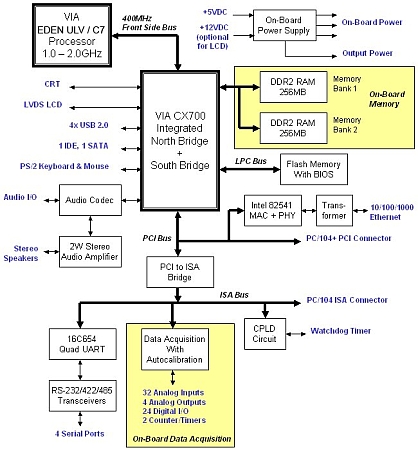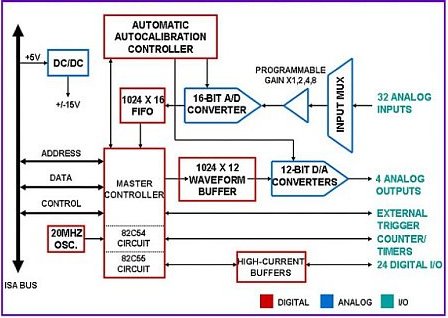EPIC SBC specializes in data acquisition
Nov 19, 2007 — by LinuxDevices Staff — from the LinuxDevices Archive — 15 views [Updated Nov. 21] — Diamond Systems says it is now shipping an EPIC form-factor single-board computer (SBC) with integrated data acquisition capabilities. The Poseidon features Via's C7 or Eden processors, and supports both Linux- and Windows-based operation, according to the company.
[Updated Nov. 21] — Diamond Systems says it is now shipping an EPIC form-factor single-board computer (SBC) with integrated data acquisition capabilities. The Poseidon features Via's C7 or Eden processors, and supports both Linux- and Windows-based operation, according to the company.
(Click here for a larger view of the Diamond Poseidon)
The Poseidon, which was originally announced in April 2006, is designed for harsh environments, says Diamond. It is available with a 1GHz Via Eden ULV processor, or a 2GHz Via C7. It also features Via's CX 700, a combined northbridge/southbridge chip that saves board area and design complexity.

Poseidon block diagram
(Click to enlarge)
The SBC features 256MB or 512MB of soldered-on 533MHz DDR2 DRAM, along with a 400MHz front-side bus. The CX700's built-in graphics capability is derived from Via's 128-bit UniChrome Pro IGP core, which with open source Linux drivers provides 2D and MPEG-2 acceleration, with closed drivers required for 3D acceleration. The board supports simultaneous CRT and LVDS flat-panel displays.
According to the company, the Poseidon offers an optional integrated data acquisition section. This has 32 analog inputs with 16-bit A/D and 250KHz sample rate, four 12-bit analog outputs with 100KHz waveform output capability, 24 digital I/O lines, and two counter/timers.

Poseidon's data acquisition subsystem
The analog circuitry uses Diamond's “patented automatic auto-calibration” technology to calibrate its A/D and D/A intervention, according to the company. It supports both interrupt and DMA A/D transfers, and uses an enhanced 1,024-sample FIFO with programmable threshold.
Features and specifications listed by Diamond for the Poseidon include:
- Processor — 1GHz Via Eden ULV or 2GHz Via C7
- Memory — 256 or 512MB of soldered-on RAM
- Graphics capabilities:
- 2048 x 1536 pixel CRT resolution
- 1600 x 1200 flat-panel resolution
- 128MB of shared video memory
- 2048 x 1536 pixel CRT resolution
- Networking — 10/100/1000 Ethernet
- Other I/O:
- 4 x USB 2.0
- 4 x serial ports (2 x RS-232; 2 x RS-232/422/485)
- PS/2 keyboard/mouse port
- SATA
- IDE UDMA 100
- “flash disk interface”
- Audio in/out; mic; amplified speaker interface
- 4 x USB 2.0
- Expansion — PC/104-Plus stack location
- Dimensions — 6.5 x 4.5 inches (165 x 115 mm)
- Weight — approx. 9 ounces
Diamond says that in order to enhance the use of the Poseidon SBC in harsh environments, it is engineered with all on-board I/O brought to pin headers within the I/O zones identified in the EPIC specification. However, I/O that can utilize PC-style connectors is placed adjacent to an optional panel I/O board, allowing use in a suitably equipped enclosure. This panel I/O board is included in a development kit that also includes the Poseidon, cables, and a software CD. The development kit includes a flash-disk module with Linux pre-loaded, Diamond said.
Asked about Linux support, Diamond spokesperson David Fastenau replied, “In brief support for Poseidon is based on the 2.6.19 Kernel. Other than a kernel configuration to add support for Gigabit Ethernet and support for CX700 graphics on the chipset, this is a standard distribution. For the HDD kit we use slackware, for the FD we use busybox. Our contribution in terms of Linux drivers is DSCUD that supports DAQ. Poseidon has a DMM-32X build into it so it uses the same drivers that those for the DMM32X.”
Availability
The Poseidon SBC is available now, with prices starting at $695, according to the company.
This article was originally published on LinuxDevices.com and has been donated to the open source community by QuinStreet Inc. Please visit LinuxToday.com for up-to-date news and articles about Linux and open source.